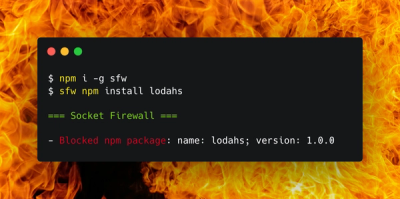
Security News
PodRocket Podcast: Inside the Recent npm Supply Chain Attacks
Socket CEO Feross Aboukhadijeh discusses the recent npm supply chain attacks on PodRocket, covering novel attack vectors and how developers can protect themselves.
@cycle/collection
Advanced tools
An easier way to do collections in Cycle
Components can be hard to manage in Cycle.js. They can be especially painful when you're working with lists of components.
Collection is a helper function that makes managing your lists of components a cinch.
$ npm install @cycle/collection --save
import Collection from '@cycle/collection';
Let's say we have a TodoListItem component, and we want to make a TodoList.
function TodoListItem (sources) {
// ...
return sinks;
}
You can make a collection stream by calling Collection() and passing it a component.
const todoListItems$ = Collection(TodoListItem);
It's common in Cycle that you want to pass your sources to your children. You can pass a sources object as the second argument. Each item in the collection will be passed these sources.
const todoListItems$ = Collection(TodoListItem, sources);
To actually populate the collection, you pass an add$ stream. Its emitted values may be sources objects, which will be merged with the sources object you passed when you created the collection$. This is useful for passing props$. For Collection versions 0.6.0+ (based on Cycle Unified), any stream type supported by Cycle.js should work automatically. See the old README if you are older versions of Cycle.js (Cycle.js Diversity).
const todoListItems$ = Collection(TodoListItem, sources, xs.of(additionalSources));
add$ can emit an array, if multiple items should be added at once.
const todoListItems$ = Collection(TodoListItem, sources, xs.of([firstSources, secondSources]));
Collection() returns a stream with arrays of items as values. Those arrays are cloned from internal ones, so changes will not impact the state of the collection$.
Collections are immutable. This is because in Cycle.js values that change are represented as streams.
If we put it all together in our TodoList it looks like this:
function TodoList (sources) {
const addTodo$ = sources.DOM
.select('.add-todo')
.events('click')
.mapTo(null); // to prevent adding click events as sources
const todoListItems$ = Collection(TodoListItem, sources, addTodo$);
const sinks = {
DOM: xs.of(
div('.todo-list', [
button('.add-todo', 'Add todo')
])
)
}
return sinks;
}
todoListItems to show up in the DOM?Collection.pluck to the rescue!
const todoListItemVtrees$ = Collection.pluck(todoListItems$, item => item.DOM);
Collection.pluck takes a collection stream and a selector function and returns a stream of arrays of the latest value for each item. Selector function takes the sinks object and returns a stream. So for the DOM property each item in the stream is an array of vtrees. It handles the map/combine/flatten for you and also ensures that any vtree streams have unique keys on their values. This improves performance quite a bit and helps snabbdom tell the difference between each item.
We can now map over todoListItemVtrees$ to display our todoListItems.
function TodoList (sources) {
const addTodo$ = sources.DOM
.select('.add-todo')
.events('click')
.mapTo(null); // to prevent adding click events as sources
const todoListItems$ = Collection(TodoListItem, sources, addTodo$);
const todoListItemVtrees$ = Collection.pluck(todoListItems$, item => item.DOM);
const sinks = {
DOM: todoListItemVtrees$.map(vtrees =>
div('.todo-list', [
button('.add-todo', 'Add todo'),
div('.items', vtrees)
])
)
}
return sinks;
}
There is another common and hard to solve problem with lists in Cycle.js.
Say our TodoListItem has a 'remove' button. What happens when you click it?
A TodoListItem can't really remove itself. The state of the parent element needs to change.
All that a TodoListItem can do is return a remove$ stream as part of it's sinks, along with DOM.
Normally, to solve this problem you would need to create a circular reference between the sinks of the items in your collections and the stream of reducers you're folding over. This is achieved using imitate in xs or Subject in rx. This can be tricky code to write and read, and often adds quite a bit of boilerplate to your component.
When you create a Collection you can optionally pass a removeSelector function that returns a stream which will trigger item's removal.
const todoListItems$ = Collection(TodoListItem, sources, add$, item => item.remove$);
All together now!
function TodoList (sources) {
const addTodo$ = sources.DOM
.select('.add-todo')
.events('click')
.mapTo(null); // to prevent adding click events as sources
const todoListItems$ = Collection(TodoListItem, sources, addTodo$, item => item.remove$);
const todoListItemVtrees$ = Collection.pluck(todoListItems$, item => item.DOM);
const sinks = {
DOM: todoListItemVtrees$.map(vtrees =>
div('.todo-list', [
button('.add-todo', 'Add todo'),
div('.items', vtrees)
])
)
}
return sinks;
}
It's a quite common use case when a collection is built from fetched data. Usually it comes in a form of items' state snapshot. Collection.gather takes a stream of those snapshots and turns into a stream of collections. It takes Collection and sources arguments, just as Collection does, plus the snapshots stream itemState$, an optional idAttribute argument, which defaults to 'id', and an optional transformKey function for converting source keys.
const tasks$ = Collection.gather(Task, sources, fetchedTasks$, 'uid', key => `${key}$`) // converts 'props' in snapshots to 'props$' in sources
It uses a set of rules:
idAttribute.There are kinds of sinks that rather represent actions than states. HTTP sink is a good example. If we want to get a stream of all HTTP requests issued by collection's items, Collection.merge will provide us one. It works basically the same as Collection.pluck, but merges the sinks instead of combining them into array.
const tasksRequest$ = Collection.merge(tasks$, item => item.HTTP);
Importing Collection directly is the same as calling makeCollection().
FAQs
Manage a collection of item in your dataflow component
We found that @cycle/collection demonstrated a not healthy version release cadence and project activity because the last version was released a year ago. It has 3 open source maintainers collaborating on the project.
Did you know?

Socket for GitHub automatically highlights issues in each pull request and monitors the health of all your open source dependencies. Discover the contents of your packages and block harmful activity before you install or update your dependencies.

Security News
Socket CEO Feross Aboukhadijeh discusses the recent npm supply chain attacks on PodRocket, covering novel attack vectors and how developers can protect themselves.

Security News
Maintainers back GitHub’s npm security overhaul but raise concerns about CI/CD workflows, enterprise support, and token management.

Product
Socket Firewall is a free tool that blocks malicious packages at install time, giving developers proactive protection against rising supply chain attacks.